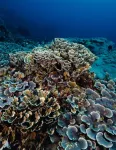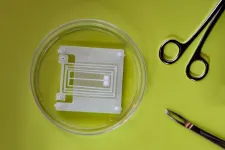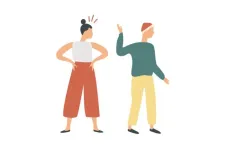(Press-News.org)
University of Michigan researchers have discovered that a worm commonly used in the study of biology uses a set of proteins unlike those seen in other studied organisms to protect the ends of its DNA.
In mammals, shelterin is a complex of proteins that "shelters" the ends of our chromosomes from unraveling or fusing together. Keeping chromosomes from fusing together is an important job: chromosomes carry our body's DNA. If chromosome ends fuse, or if they fuse with other chromosomes, the cell that houses these chromosomes dies.
But not all organisms use the same kinds of proteins to form shelterin. The worm C. elegans has been a powerful model for understanding many types of biological processes, says Jayakrishnan Nandakumar, U-M professor of molecular, cellular, and developmental biology.
Until recently, however, scientists had not identified the proteins that protect the double-stranded DNA ends of their chromosomes, called telomeres. In 2021, Nandakumar's collaborator Hiroki Shibuya and another group independently discovered that proteins in C. elegans, called TEBP-1 and TEBP-2, protected the worm's telomeric ends.
Still, researchers hadn't yet unraveled all of the mysteries of C. elegans shelterin. Proteins can have several parts to them, with each part performing a different function, Nandakumar says. These parts are called "domains," which are named after the function they perform. Researchers weren't sure which domain allowed one TEBP-1 or TEBP-2 molecule to bind to another copy of itself and then which domain bound the proteins to chromosome DNA to help protect it.
Now, Nandakumar and his team have identified the specific domains within TEBP-1 and TEBP-2 proteins that allow them to perform their biological functions. Their findings are published in the Proceedings of the National Academy of Sciences.
"There are different means to achieve the same end (the pun is intended). In other words, because of our focus on mammalian telomeres, we tend to bias ourselves in thinking 'our way' is the right way or the only way to solve problems in the cell," he said. "However, the C. elegans example shows us that there are multiple ways to solve the end protection problem and some of them might be quite different from how humans do it. But as long as they are effective, they are selected for in evolution."
Nandakumar says to think of chromosomes as a shoelace. The ends of your shoelace are coated with a hard plastic shell called an aglet, which protects the lace from unraveling. Humans—and all mammals—have a certain set of proteins that are the primary components of shelterin, the "aglet" of the chromosome.
"Think of these proteins as the plastic aglet that coats the ends of chromosomes to protect them from degradation and preserve their integrity," Nandakumar said. "In C. elegans, TEBP-1 and TEBP-2 protect the chromosome ends."
Now, these proteins, both in mammals and in C. elegans, need a way to bind to each other and then to bind to the chromosome so that they can effectively coat the chromosome end. They do this using what's called a dimerization domain as well as a DNA binding domain part (when two identical protein molecules bind together, researchers say they "dimerize"). In mammals, a domain called "TRFH" dimerizes these proteins, and a different domain called the "myb" domain coats the chromosome ends.
Researchers hadn't yet identified the C. elegans TEBP-1 or TEBP-2 dimerization and DNA binding domains because they were looking for a protein in C. elegans that shared a similar amino acid sequence to the human protein domains—that is, they were looking for a homolog of those proteins. But there wasn't one.
Instead, C. elegans has three copies of something else, something that looks similar to the myb domain on the mammalian proteins. So the research team called them "myb-containing domain," or MCD 1, 2 and 3. A single protein of TEBP-1 and TEBP-2, then, includes three segments: MCD1, MCD2 and MCD3.
The researchers further found that only MCD3 binds DNA. MCD1 and MCD2 look like a DNA binding domain, but instead bind together molecules of TEBP-1 and TEBP-2. MCD1 in one protein binds to MCD1 in the next protein and MCD2 binds to MCD2, allowing the proteins to link up to surround the ends of the chromosomes.
To connect the protein complexes to the telomeres, MCD3 binds to the chromosome DNA. This whole protein is repeated around the entire long end of the chromosome.
Nandakumar says that because you can perform biochemistry and genetics readily with C. elegans, understanding the protein complexes that protects its telomeres will help researchers use it as a model organism for studying telomere biology.
"Protecting the telomeres of your DNA—every eukaryote has to do it, meaning that a worm has to somehow figure that out. Humans have to figure it out. Yeast has to figure it out. It's a universal problem," Nandakumar said. "Generally, in evolution, you would use that same strategy in different species. If something is working, if you have a solution to a problem, why not reuse it? I think the cool thing is, you can have multiple solutions to the problem."
Study: C. elegans chromosome end protection proteins TEBP-1 and TEBP-2 adapt the Myb module to dimerize and bind telomeric DNA (DOI: 10.1073/pnas.2316651121) (available when embargo lifts)
END
Different means to the same end: How a worm protects its chromosomes
2024-04-08
ELSE PRESS RELEASES FROM THIS DATE:
ADA Forsyth scientists discover new phage resistance mechanism in phage-bacterial arms race
2024-04-08
One of the most abundant and deadliest organisms on earth is a virus called a bacteriophage (phage). These predators have lethal precision against their targets – not humans, but bacteria. Different phages have evolved to target different bacteria and play a critical role in microbial ecology. Recently, ADA Forsyth scientists exploring the complex interactions of microbes in the oral microbiome discovered a third player influencing the phage-bacterial arms race – ultrasmall bacterial parasites, called Saccharibacteria or TM7.
In the study, which appeared in Proceedings of the National Academy of Sciences ...
Deep parts of Great Barrier Reef ‘insulated’ from global warming – for now
2024-04-08
Some deeper areas of the Great Barrier Reef are insulated from harmful heatwaves – but that protection will be lost if global warming continues, according to new research.
High surface temperatures have caused mass “bleaching” of the Great Barrier Reef in five of the last eight years, with the latest happening now.
Climate change projections for coral reefs are usually based on sea surface temperatures, but this overlooks the fact that deeper water does not necessarily experience the same warming as that at the surface.
The new study – ...
How climate change will impact food production and financial institutions
2024-04-08
Researchers at the University of California San Diego School of Global Policy and Strategy have developed a new method to predict the financial impacts climate change will have on agriculture, which can help support food security and financial stability for countries increasingly prone to climate catastrophes.
The study, published today in the Proceedings of the National Academy of Sciences, uses climate and agricultural data from Brazil. It finds that climate change has a cascading effect on farming, leading to increased loan defaults for ...
MSU researchers find more action needed to prevent arthritis
2024-04-08
MSU has a satellite uplink/LTN TV studio and Comrex line for radio interviews upon request.
EAST LANSING, Mich. – The prevalence of early knee osteoarthritis (OA) symptoms faced by patients after anterior cruciate ligament (ACL) reconstruction is staggering — but not much is being done to address it according to new research published by scholars from Michigan State University’s Department of Kinesiology.
The study – published by the Journal of Athletic ...
Americans are bad at recognizing conspiracy theories when they believe they’re true
2024-04-08
Conspiracy theorists get a bad rap in popular culture, yet research has shown that most Americans believe conspiracy theories of some sort. Why then, if most of us believe conspiracies, do we generally think of conspiracy theorists as loony?
New research from the University of Illinois Chicago found that it’s because people are quite bad at identifying what is or isn’t a conspiracy theory when it’s something they believe. The finding held true whether people self-identified as being liberal ...
Skin pigmentation bias in pulse oximeters to get closer look
2024-04-08
By Beth Miller
Pulse oximeters send light through a clip attached to a finger to measure oxygen levels in the blood noninvasively. Although the technology has been used for decades — and was heavily used during the COVID-19 pandemic — there is increasing evidence that it has a major flaw: it may provide inaccurate readings in individuals with more melanin pigment in their skin. The problem is so pervasive that the U.S. Food & Drug Administration recently met to find new ways to better evaluate the accuracy and performance of the devices in patients with more pigmented skin.
Christine O’Brien, assistant professor of biomedical ...
Gendered recommendations in 19th century list of books for boys and girls set the stage for field of children’s literature today
2024-04-08
Children’s literature became a distinct category during the Progressive Era in the United States, largely through the work of professional “book women” like children’s librarians, publishers, and teachers. In a chapter in a new book, researchers examine one of the first attempts to formalize a selection of existing literature into a canon of children’s books, the 1882 pamphlet Books for the Young by Caroline M. Hewins. They also analyze the books selected by Hewins, with a focus on books designated for boys only and for girls only.
The ...
MU center projects a dip in farm income for springtime
2024-04-08
Another decline in net farm income is projected for the Show-Me State, according to the Spring 2024 Missouri Farm Income Outlook released by the University of Missouri’s Rural and Farm Finance Policy Analysis Center (RaFF).
The report offers a state-level glimpse at projected farm financial indicators, including farm receipts, production expenses and other components that affect net farm income. Projections from the report suggest that declining market receipts and lower crop prices play a role in the estimated $0.8 billion decrease in net farm income for 2024.
“Although decreased production expenses offer some relief, reduced livestock inventories ...
MIT engineers design soft and flexible “skeletons” for muscle-powered robots
2024-04-08
Our muscles are nature’s perfect actuators — devices that turn energy into motion. For their size, muscle fibers are more powerful and precise than most synthetic actuators. They can even heal from damage and grow stronger with exercise.
For these reasons, engineers are exploring ways to power robots with natural muscles. They’ve demonstrated a handful of “biohybrid” robots that use muscle-based actuators to power artificial skeletons that walk, swim, pump, and grip. But for every bot, there’s a very different build, and no general blueprint for how to get the most out of muscles ...
Your unsupportive partner is physically stressing you out
2024-04-08
BINGHAMTON, N.Y. -- Couples feel more understood and cared for when their partners show positive support skills – and it’s evidenced by levels of the stress hormone cortisol in the body – according to new research from Binghamton University, State University of New York.
A team of Binghamton University researchers including Professor of Psychology Richard Mattson conducted a study of 191 heterosexual married couples to find out if better communication skills while giving and receiving social support led to lower cortisol levels ...



